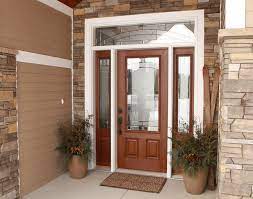Replacing the Front Entry System Adds Value
A new front entry upgrade instantly improves your home’s curb appeal and is a smart investment that saves energy and adds value to your home. In a recent survey released by the National Association of Realtors, the replacement of an exterior door held the most value and recouped the most cost of any exterior improvement project.
Many advances in the past ten years have made new front entry doors more energy efficient. For example, the new steel and fiberglass front entry doors have dense cores that make them more effective at insulating your home and resisting heat build up compared to solid wood doors. As an added bonus, the majority of these new front entry doors are not easily dented or dinged, nor do they warp or split like a traditional custom entry door, making them somewhat maintenance-free as well as perennially visually appealing.
Here are a few tips to consider when choosing your entry door to ensure you find the perfect fit for your home.
1. Door Styles
A front door reflects the personality of a home and the family who lives there. The style is one element of your home’s design, so it should compliment and enhance the overall look and feel. Style can be casual, traditional, formal or artistically reflect influences from around the world.
In most cases, the front door is the focal point and you should choose a door style with supporting glass accents, door trim, light fixtures and shrubs to create a front entry that captures the eye. If the door plays a supporting role to more intricate landscaping, you might select a simpler door style to play a role within the larger image you’re creating.
2. Consider Your Environment
You need to consider the environment that your door will face. Your entry door is the first line of defense against the elements. If your door cannot stand up to the wind, snow, rain, heat, cold and more you will lose money in energy costs every year. Your entry system is comprised of more than just a door – the components that make up the system (the frame, sill, hinges, lock, and more) also determine how efficient and durable your entry door is. With premium components your door can withstand the elements and last for years.
3. Wood, Fiberglass, or Steel?
There are three basic options for entry door material – wood, fiberglass, and steel. Each has its advantages and disadvantages, it is important to consider each carefully and determine which suits your needs best.
• Wood – Wood doors are considered the go-to choice for high-end projects. Since wood has an implication of being upscale it’ll make any home appear more extravagant and sophisticated. Natural wood textures can complement any number of architectural styles and bring undeniable character and charm to a home. Remember though that continuous care, maintenance and a professional grade finish are musts to ensure long-term performance and beauty with a wood door. Key factors in wood door performance are adequate roof overhang, minimal sun exposure, and proper sill height.
• Fiberglass – Fiberglass doors offer durability and beauty. There are hundreds of fiberglass options available that offer the look of real wood, but unlike real wood, fiberglass will not expand or contract as the weather changes. Fiberglass doors offer superior durability, resisting denting, splitting, cracking, and warping to offer long-term performance. Properly finished, most fiberglass doors can go years without needing a paint or stain touch-up.
• Steel – The most affordable option for entry doors is steel. Steel doors may offer excellent strength, security and insulation, but are very susceptible to denting resulting in difficult and expensive repairs. Compared to wood and fiberglass, steel doors do not stand up as well to normal wear and tear.
4. Components, Accessories and Features
As stated earlier, your entry door is about more than just your door slab. It is about all the components, accessories and features that make up the entry system. There are a number of features to consider before purchasing an entry system:
• Security – When it comes to security, consider the material you chose and the lock accessories available. While steel is often touted as stronger than wood or fiberglass, the difference is not significant. Regardless of which door material you choose, make sure the door slab fits tightly into the frame and make sure the door is fitted with secure, high quality door locks. Multi-point locks provide superior security and help prevent warping, wind deflection and drafts which help keep heating cooling costs low and the elements out.
• Door Frame (Head, Jamb, Mull, Sill) – A continuous frame system provides a consistent foundation to maximize stability and functionality. Make sure that your frame is going to stand up against the elements. Look for wood composite systems that won’t absorb water like real wood as this will help prevent rotting and warping.
• Glass – If you can imagine it, you can get it. There are hundreds of glass options to choose from – clear glass, decorative glass, full view, half view, single sidelite, double sidelite, arched, rectangular, and the list goes on. Glass can add beautiful character to your entry system, however make sure that you research the energy and privacy ratings before purchasing so you are not surprised later.
5. Do Your Research
With thousands of manufacturers, hundreds of dealers, and endless options to choose from, research your options before making a purchasing decision. You want your entry system to last for years to come so don’t skimp out and go for the lowest price – find the best value. Make sure the system you choose reflects your style, fits your needs, and will hold up to the environment. Your entry system is one of the most heavily used and visible parts of your home.


